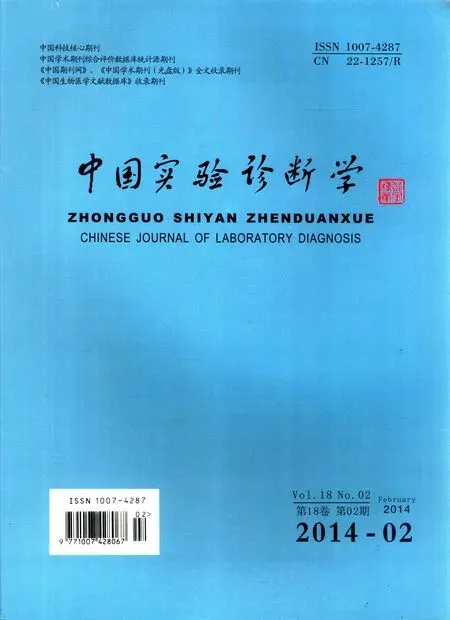高渗盐水复苏缺血小肠对小肠免疫屏障和系统炎性反应综合征的影响
张森森,朱振新,吴洪坤,周 琳,仲人前*
高渗盐水复苏缺血小肠对小肠免疫屏障和系统炎性反应综合征的影响
张森森1,朱振新2,吴洪坤1,周 琳1,仲人前1*
(1.第二军医大学附属长征医院实验诊断科,上海200003;2.第二军医大学附属长征医院胃肠外科,上海200003)
目的 本研究拟证实利用高渗盐水进行液体复苏可保护缺血-再灌注过程中的肠道黏膜屏障功能,并减轻该过程中机体系统性炎症反应综合征(SIRS),从而为临床大出血、严重感染、大面积烧伤后肠功能障碍患者液体复苏方案的选择提供新的策略方法和理论依据.方法 ①选用清洁级雄性Sprague-Dawley(SD)大鼠,体重250g-300g,通过肠系膜上动脉夹闭法建立大鼠小肠缺血-再灌注损伤模型。②选用清洁级雄性Sprague-Dawley(SD)大鼠,随机分为假手术组(Sham组),缺血-再灌注损伤组(IR组)和高渗盐水复苏组(HS组)。IR组夹闭肠系膜上动脉1h后开放并经尾静脉输入0.9%氯化钠溶液;HS组夹闭肠系膜上动脉1h后开放并经尾静脉输入7.5%氯化钠溶液;Sham组操作方法同IR组,但不进行肠系膜上动脉夹闭。再灌注6h后取标本。③免疫组化检测小肠粘膜内淋巴细胞(intraepithelial lymphocyte,IEL)和固有层淋巴细胞(lamina propria lymphocytes,LPL)中T细胞亚群改变;流式细胞术检测大鼠外周血T细胞亚群及NK细胞。结果 ①肠黏膜上皮细胞层中的上皮内淋巴细胞(IEL)和位于疏松结缔组织中的固有层淋巴细胞(LPL)中CD4+T细胞数量和CD8+细胞数量,IR组和HS组显著高于Sham组,HS组显著高于IR组。②外周血T细胞亚群及NK分析:HS组CD3+CD8+T细胞显著低于IR组和Sham组(P<0.05),HS组NK细胞比例显著低于IR组和NS组(P<0.05),余未见显著性差异。结论 利用高渗盐水复苏缺血小肠,可有效保护小肠免疫屏障,抑制全身炎性反应综合征。
缺血-再灌注损伤;高渗盐水;液体复苏;肠粘膜免疫屏障;系统炎性反应综合征
Key words:Ischemia-reperfusion injury;hypertonic saline;fluid resuscitation;intestinal mucosal immune barrier;system inflammatory response syndrome
(Chin J Lab Diagn,2014:18:0188)
小肠缺血-再灌注损伤不仅导致小肠形态学上的改变,更导致其小肠功能的受损[1,2]。临床更多注意的是肠道屏障功能,它是由上皮、分子与免疫等组成的复杂功能,它能防止肠道内细菌、细菌产物逸至肠道外进入机体[3,4]。而肠道含有大量淋巴细胞,能分泌许多细胞因子及炎症介质,以刺激与调控肠的免疫功能,构成了肠道的免疫屏障[5,6],其功能受损将严重影响肠道屏障,引起肠道菌群移位,从而导致肠道菌群异位、系统炎性反应综合征以及多器官功能衰竭的发生[7,8]。
关于高渗盐水是否在大鼠小肠缺血-再灌注损伤过程中对小肠免疫屏障具有保护作用,本研究利用高渗盐水复苏缺血小肠观察对小肠粘膜免疫屏障的影响。
1 材料和方法
1.1 材料
1.1.1 实验动物与分组 健康雄性SD大鼠,体重250-300g,第二军医大学实验动物中心提供,健康状况符合国家普通实验动物健康标准。随机分3组,每组8只:①假手术组(Sham组);②缺血-再灌注损伤组(IR组);③高渗盐水复苏组(HS组)。
1.1.2 主要仪器和试剂 小型低温离心机器(中科中佳,美国),流式细胞分析仪(BD,美国),超纯水仪(Pall,美国),光学显微镜(Olympus,日本),10%水合氯醛(上海第一生化药业有限公司,上海),4%多聚甲醛磷酸盐缓冲液(碧云天生物技术有限公司,上海),大鼠淋巴细胞分离液(碧云天生物技术有限公司,上海),0.05Tris—HCl缓冲液(碧云天生物技术有限公司,上海)等。
1.2 实验方法
1.2.1 大鼠经10%水合氯醛(4ml/kg)腹腔注射麻醉,麻醉成功后,取上腹部正中切口约5cm,暴露出小肠后,向左侧翻开小肠即可暴露出肠系膜上动脉;于根部钝性分离肠系膜上动脉,IR组和HS组大鼠是用动脉夹于根部将肠系膜上动脉夹闭,然后将小肠回复原位,腹壁双层缝合。1h后再次经原切口进入腹,取出肠系膜上动脉根部动脉夹后关腹。关腹后IR组经尾静脉注入0.9%NaCl(6ml/kg),HS组经尾静脉注入7.5%NaCl(6ml/kg)。Sham组大鼠除肠系膜上动脉夹闭过程外,所有操作步骤同IR组。
1.2.2 液体复苏6h后,各组大鼠再次经腹腔麻醉。取距屈氏韧带1cm处空肠,取距回盲部1cm回肠,剪开并清除肠内容物;经腹主动脉取外周血迅速置入EDTA抗凝管中晃匀,4℃保存并2h内检测T细胞亚群及NK细胞。
1.2.3 小肠上皮内淋巴细胞(IEL)和固有层淋巴细胞(LPL)中CD4+淋巴细胞、CD8+淋巴细胞计数
①10%中性甲醛固定后,常规石蜡包埋并切片。②切片脱蜡入水,入PAS洗3次/15min。③封闭内源性过氧化物酶。用新配置的0.3%H2O2(在0.05Tris—HCl缓冲液pH7.6)室温,30分钟。④水洗,入PBS,洗3次,每次5min。⑤分别滴加兔抗大鼠CD4多克隆抗体和兔抗大鼠CD8多克隆抗体,4℃过液。⑥0.1MPBS,洗3次,每次5min。⑦滴加goat polyclonal antibody against rabbit EnVision-HRP,室温40min。⑧0.1MPBS洗净,洗3次,每次5min。⑨DAB-H2O2显色:用0.01%H2O2的DAB溶液,室温5-30min,镜检。⑩自来水洗净。○11用Mayer苏木精复染胞核。○12常规脱水、透明、封固。○13光镜下(×125)观察随机获取10个视野,每个视野随机寻找相对完整的小肠隐窝,计数每20个隐窝中阳性细胞个数并重复3次,然后求所有10个视野的平均值[9]。
1.2.4 大鼠外周血T细胞亚群及NK细胞检测①加入0.4ml大鼠淋巴细胞分离液于离心管中。②取大鼠外周血约0.2ml收集于EDTA抗凝管中,加入等体积PBS缓冲液后混匀后,小心沿离心管壁将外周血混合液置于淋巴细胞分离液的上层,2 000rpm离心20min。
1.2.5 统计学处理 数据结果以均数±标准差(_x±s)表示。统计分析采用SPSS 11.5(SPSS Inc.,Chicago,IL,USA)统计软件包。采用单因素方差分析(one-way ANOVA)法,组间比较采用Bonferroni法。P<0.05为统计学有显著性差异。
2 结果
2.1 小肠粘膜CD4+T细胞和CD8+细胞的表达
IEL、LPLCD4+T细胞数量和CD8+细胞数量详见表1及图1(见封三)。与Sham组相比,IR组和HS组中IEL、LPL中CD4+T细胞数量和CD8+细胞数量均出现增高(P<0.01),而HS组中CD4+T细胞数量和CD8+细胞数量显著高于IR组(P<0.01)。

表1 小肠上皮内淋巴细胞(IEL)、固有层淋巴细胞(LPL)CD4+T细胞CD8+T细胞数量(_x±s)
2.2 外周血T细胞亚群和NK细胞分析
外周血T细胞亚群和NK细胞分析结果详见表2及图2(见封三)。与Sham组相比、IR组和HS组CD3+CD4+T cells比例未见统计学差异,CD3+细胞和NK细胞比例降低(P<0.05),同时HS组CD3+CD8+T细胞比例要低于与Sham组(P< 0.05),而IR组和Sham组相比则未见统计学差异(P>0.05)。HS组与IR组相比,CD3+细胞、CD3+CD4+T细胞未见统计学差异(P>0.05),HS组中CD3+CD8+T比例显著低于IR组(P<0.05),而NK细胞比例显著低于IR组(P<0.05)。

表2 外周血CD3+CD4+T细胞,CD3+CD8+T细胞和NK细胞的数量和比例
3 讨论
肠黏膜屏障包括机械屏障,生物屏障、化学屏障和免疫屏障[10,11]。肠黏膜免疫屏障主要由肠道相关淋巴组织(gut-associated lymphoid tissue,GALT)的细胞群所组成[12,13]。GALT是人体拥有最大的黏膜相关淋巴组织(mucosa-associated lymphoid tissue,MALT),按功能可分为“诱导部位”和“效应部位”两部分[14]。诱导部位主要由滤泡相关上皮(follicle associated epithelium,FAE)构成,存在于派氏淋巴小节(Peyer’s patches,PP)的表面[15,16]。主要负责向其基底侧的抗原呈递细胞(antigen presenting cell,APC)转运肠腔内的抗原,抗原经APC细胞处理后再呈递给“效应部位”,即效应淋巴细胞,诱发肠道相关免疫反应[17]。
肠黏膜免疫屏障中分散在上皮细胞层中的上皮内淋巴细胞(IEL)和位于疏松结缔组织中的固有层淋巴细胞(LPL)发挥了重要作用。人类IEL大多数为T淋巴细胞,参与机体免疫监护和免疫防御作用[18,19]。在受到刺激时,IEL可通过分泌多种细胞因子或产生不同的细胞毒作用,发挥其杀伤活性,清除病毒感染或损伤的上皮细胞。LPL主要由T淋巴细胞和B淋巴细胞、浆细胞组成。另外还有巨噬细胞(约10%)、嗜酸性粒细胞(约5%)、黏膜肥大细胞(约1%~3%)和树突状细胞,分布在血管和淋巴管丰富的结缔组织中[20,21]。T淋巴细胞按细胞分化群(CD)分子不同分为CD4+和CD8+两大亚群,CD4+是辅助性T淋巴细胞,参与TCR识别特异性抗原肽-MHC-Ⅱ类分子复合物和信号转导。小肠粘膜中CD4+T淋巴细胞可能是对流注到肠淋巴结内的抗原进行识别、发生应答、再返回到固有层的T淋巴细胞。CD8+呈毒性T淋巴细胞,参与TCR识别特异性抗原肽-MHC-Ⅰ类分子复合物和信号转导,小肠粘膜中CD8+T细胞主要介导溶细胞效应,发挥细胞免疫作用。CD4+T细胞和CD8+T细胞彼此相互调节,维持肠道粘膜免疫屏障功能。
在小肠缺血-再灌注损伤过程中,我们发现,无论是上皮内淋巴细胞,还是固有层淋巴细胞,CD4+T细胞和CD8+T细胞都出现数量上的上调。CD4+T细胞发挥辅助性T淋巴细胞作用,参与抗原识别,介导细胞免疫反应,而CD8+通过识别特异性抗原肽,发挥细胞毒性作用介导细胞溶解。在缺血再灌注损伤过程中,CD4+T细胞和CD8+T细胞数量上的上调,是肠粘膜T细胞一种主动防御功能的体现。小肠缺血-再灌注损伤将导致机械屏障,生物屏障、化学屏障遭受重创,而通过淋巴细胞数量的上调,尽可能维持受损的肠粘膜屏障。而利用高渗盐水对缺血小肠进行复苏,我们观察到小肠上皮内淋巴细胞和固有层淋巴细胞均较缺血-再灌注损伤后利用生理盐水进行附属组有显著性增高,说明高渗盐水更有利于维护缺血-再灌注损伤后肠道粘膜免疫屏障。
缺血-再灌注损伤不仅导致小肠损伤,更可由于肠粘膜屏障损伤,导致肠道菌群入血,从而使系统全身免疫状态出现改变。为明确高渗盐水复苏后,小肠粘膜局部免疫状态和系统免疫状态之间的关系,我们对外周血T淋巴细胞亚群和NK细胞进行了检测。CD3+细胞百分率测定的结果,反映成熟的总T淋巴细胞水平。CD3+细胞百分率下降,表示成熟的总T淋巴细胞减少,细胞免疫功能减弱[22],而T细胞亚群比率和NK细胞的数量与机体免疫系统功能密切相关[23,24]。经检测我们发现,外周血T细胞数量及亚群的变化与肠粘膜CD4+T细胞与CD8+T细胞变化趋势并不完全一致,这说明高渗盐水导致肠道黏膜淋巴细胞变化与全身淋巴细胞改变无关。在本研究中,我们观察到外周血NK细胞HS组较IR组为低,这可能由于利用高渗盐水复苏后,由于肠道粘膜较好的受到保护,全身反应较IR组为轻,从而引起较低的机体免疫反应。
[1]Varga J,Toth S,Jr,Toth S,et al.The relationship between morphology and disaccharidase activity in ischemia-reperfusion injured intestine[J].Acta Biochim Pol,2012,59(4):631.
[2]Taha MO,Miranda-Ferreira R,Chang AC,et al.Effect of ischemic preconditioning on injuries caused by ischemia and reperfusion in rat intestine[J].Transplant Proc,2012,44(8):2304.
[3]Ningappa M,Ashokkumar C,Ranganathan S,et al.Mucosal plasma cell barrier disruption during intestine transplant rejection[J].Transplantation.2012,94(12):1236.
[4]Pinton P,Tsybulskyy D,Lucioli J,et al.Toxicity of deoxynivalenol and its acetylated derivatives on the intestine:differential effects on morphology,barrier function,tight junction proteins,and mitogen-activated protein kinases[J].Toxicol Sci,2012,130(1):180.
[5]Rendon JL,Li X,Akhtar S,et al.Interleukin-22modulates gut epithelial and immune barrier functions following acute alcohol exposure and burn injury[J].Shock,2013,39(1):11.
[6]Su L,Wang JH,Cong X,et al.Intestinal immune barrier integrity in rats with nonalcoholic hepatic steatosis and steatohepatitis[J].Chin Med J(Engl),2012,125(2):306.
[7]Davis MM,Engstrom Y.Immune response in the barrier epithelia:lessons from the fruit fly Drosophila melanogaster[J].Innate Immun,2012,4(3):273.
[8]Zou XP,Chen M,Wei W,et al.Effects of enteral immunonutrition on the maintenance of gut barrier function and immune function in pigs with severe acute pancreatitis[J].JPEN J Parenter Enteral Nutr,2010,34(5):554.
[9]deSchoolmeester ML,Little MC,Rollins BJ,et al.Absence of CC chemokine ligand 2results in an altered Th1/Th2cytokine balance and failure to expel Trichuris muris infection[J].Immunol,2003,170(9):4693.
[10]Scaldaferri F,Pizzoferrato M,Gerardi V,et al.The gut barrier:new acquisitions and therapeutic approaches[J].Clin Gastroenterol,2012,46Suppl:S12.
[11]Camilleri M,Madsen K,Spiller R,et al.Intestinal barrier function in health and gastrointestinal disease[J].Neurogastroenterol Motil,2012,24(6):503.
[12]Koboziev I,Karlsson F,Grisham MB.Gut-associated lymphoid tissue,T cell trafficking,and chronic intestinal inflammation[J].Ann N Y Acad Sci,2010:E86.
[13]Luongo D,D'Arienzo R,Bergamo P,et al.Rossi M.Immunomodulation of gut-associated lymphoid tissue:current perspectives[J].Int Rev Immunol,2009,28(6):446.
[14]Nochi T,Yuki Y,Matsumura A,et al.A novel M cell-specific carbohydrate-targeted mucosal vaccine effectively induces antigen-specific immune responses[J].Exp Med,2007,204(12):2789.
[15]Asai T,Morrison SL.The SRC Family Tyrosine Kinase HCK and the ETS Family Transcription Factors SPIB and EHF Regulate Transcytosis across a Human Follicle-Associated Epithelium Model[J].Biol Chem,2013,288(15):10395.
[16]Constantinovits M,Sipos F,Molnar B,et al.Organizer and regulatory role of colonic isolated lymphoid follicles in inflammation[J].Acta Physiol Hung,2012,99(3):344.
[17]Brayden DJ,Jepson MA,Baird AW.Keynote review:intestinal Peyer's patch M cells and oral vaccine targeting[J].Drug Discov Today,2005,10(17):1145.
[18]Ebert EC.Interleukin 21up-regulates perforin-mediated cytotoxic activity of human intra-epithelial lymphocytes[J].Immunology,2009,127(2):206.
[19]Bharhani MS,Grewal JS,Peppler R,et al.Comprehensive phenotypic analysis of the gut intra-epithelial lymphocyte compartment:perturbations induced by acute reovirus 1/L infection of the gastrointestinal tract[J].Int Immunol,2007,19(4):567.
[20]Dahan S,Roda G,Pinn D,et al.Epithelial:lamina propria lymphocyte interactions promote epithelial cell differentiation[J].Gastroenterology,2008,134(1):192.
[21]Liu Z,Yadav PK,Xu X,et al.The increased expression of IL-23 in inflammatory bowel disease promotes intraepithelial and lamina propria lymphocyte inflammatory responses and cytotoxicity[J].Leukoc Biol,2011,89(4):597.
[22]Liu L,Lee J,Fu G,et al.Activation of peripheral blood CD3(+)T-lymphocytes in patients with atrial fibrillation[J].Int Heart J,2012,53(4):221.
[23]Konjevic G,Jovic V,Jurisic V,et al.IL-2-mediated augmentationof NK-cell activity and activation antigen expression on NK-and T-cell subsets in patients with metastatic melanoma treated with interferon-alpha and DTIC[J].Clin Exp Metastasis,2003,20(7):647.
[24]Claus M,Greil J,Watzl C.Comprehensive analysis of NK cell function in whole blood samples[J].Immunol Methods,2009,341(1-2):154.
Hypertonic Saline Resuscitation for Ischemic Intestine and its Impact on Immune Function of Intestine Mucosal Barrier and
ZHANG Sen-sen,ZHU Zhen-xin,WU Hong-kun,et al.
(Changzheng Hospital Affiliated to the Second Military Medical University,1.Department of Laboratory Medicine;2.Department of Gastrointestinal Surgery,Shanghai 200003,China)
Objective This study will confirm that hypertonic saline can protect small intestinal mucosal immune barrier and suppression system inflammatory response syndrome in the small intestine ischemia-reperfusion injury,which will provided new the methods and ideas in the clinical treatment of intestinal ischemia-reperfusion injury.Methods 1.Intestinal ischemia-reperfusion injury model were established through the clipping of superior mesenteric artery in Sprague-Dawley(SD)rats(weight 250g-300g).2.Sprague-Dawley(SD)rats were randomly divided into 3groups:Sham group,IR group and HS group.In IR group,the superior mesenteric artery was clipped for 1hand then resuscitate with 0.9%Nail;In Hs group the superior mesenteric artery was clipped for 1hand then resuscitate with 7.5% Nail;In the Sham group the operation is same to the IR group but without superior mesenteric artery clipping.3.T cell subsets change of small intestinal lymphocytes(IEL)and lamina propria lymphocytes(LPL),T cell subsets and NK cells in peripheral blood were observed.Results 1.CD4+T-cell and CD8+cells in cell numbers of IEL and LPL in IR group and HS group was significantly higher than that in the Sham group(P<0.01),and that in HS group was significantly higher than that in IR group(P<0.01).2peripheral blood T cell subsets and NK:In HS group,CD3+CD8+T cells was significantly lower than that in the IR group and NS group(P<0.05).NK cells in HS group was significantly lower than that in the IR group and NS group(P<0.05).No significant difference was seen in other groups.Conclusion Hypertonic saline can protect small intestinal mucosal immune barrier and suppression system inflammatory response syndrome in the small intestine ischemia-reperfusion injury.
张森森(1984-),男,江苏徐州人,学士,技师,主要从事临床检验工作。
2013-09-18)
1007-4287(2014)02-0187-05
黎介寿院士肠道屏障专项研究基金课题(LJS_201009)
*通讯作者
R574.5
A

